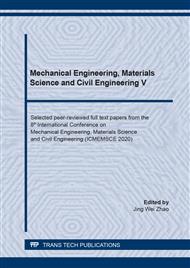p.131
p.136
p.143
p.151
p.156
p.163
p.172
p.178
p.183
Improvement of Gravelly Silty Sand Reinforced with Biaxial Bamboo Geogrid
Abstract:
In this paper, performance of gravelly silty sand soil reinforced with geogrid are present and analyzed to improve the carrying capacity. For this, the geogrid was elaborated with a renewable material like bamboo with the same dimensions of polymer geogrids biaxial. This type of soil can be used for the construction of the sub-base and base of a pavement. California Bearing Ratio (CBR) tests was carried out to obtain the bearing capacity of the silty sand soil with and without bamboo geogrid. In addition, laboratory tests were carried out to obtain the mechanical properties of the bamboo. When comparing CBR results, an improvement in the bearing capacity was evidenced with the use of bamboo geogrid with a 20% increase in the carrying capacity. Finally, maximum tensile and bending strength of bamboo were 2000 kgf/cm2 and approximately 0.018 kgf/cm, respectively.
Info:
Periodical:
Pages:
183-189
Citation:
Online since:
June 2021
Authors:
Keywords:
Price:
Сopyright:
© 2021 Trans Tech Publications Ltd. All Rights Reserved
Share:
Citation:


